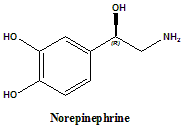NOREPINEPHRINE Synthesis, SAR, MCQ,Structure,Chemical Properties and Therapeutic Uses
Norepinephrine
IUPAC nomenclature
(R)-4-(2-amino-1-hydroxyethyl)benzene-1,2-diol.

Classification
Norepinephrine is a nonselective adrenergic agonist. [1]
Physiochemical Properties
| S. NO. | PHYSICAL AND CHEMICAL PROPERTIES | |
| 1 | Molecular weight | 169.18g/mol |
| 2 | Physical appearance | Present in colorless microcrystal form |
| 3 | Melting point | 217°C |
| 4 | Solubility | Very soluble in alkali and dilute HCL, slightly soluble in water, ethanol and diethyl ether. |
| 5 | Presence of ring | Benzene ring present |
| 6 | Number of chiral centers | 1 |
Mechanism of Action
- Norepinephrine acts on alpha-adrenergic receptors and functions as peripheral vasoconstrictor.
- It also acts on the beta-adrenergic receptors and functions as inotropic stimulator of the heart, and dilator of the coronary arteries.
Structure Activity Relationship
- Primary or secondary aliphatic amine separated by two carbons from a substituted benzene ring is essential for the high agonist activity.
- The hydroxyl substituted carbon must be in the R configuration for the maximal direct activity.
R1 substitution:
- When R1 is increased in size, activity of alpha receptors decreases and activity of the beta receptors increases
- Activity of both alpha and beta receptors is maximum when R1 is methyl group.
- Alpha agonist activity decreases when R1 is larger than methyl, and went negligible when R1 is isopropyl.
- Large lipophillic groups can afford compounds with alpha blocking activity.
- N-substituent provides selectivity for different receptors.
- Arylalkyl group can provide beta selectivity, increased cell penetration and increased lipophillicity for the longer duration of action.
R2 substitution:
- Ethyl group can eliminate the alpha activity of the drug.
- Erythrostero isomers have maximal activity.
- The additional methl group makes the drug more selective for the alpha2
R3 substitution on the aromatic ring:
- 3’,4’-dihydroxy substituted benzene ring has poor oral activity.
- 3’, 5’-dihydroxy compounds are orally active.
- At least one of the groups is required which can form hydrogen bonds. And if only one group is present then it is preferred at 4’ position to retain the beta2
- If phenyl group has no phenolic sunstituent then it may act directly or indirectly.[2]
Method of synthesis
i. Catechol reacts with chloroacetic acid and POCl3 to give 4-chloroacetylcatechol.
ii. Norepinephrine is then obtained from 4-chloroacetylcatechol.

Therapeutic Uses
The drug used for the treatment of:
- Low blood pressure
- Used during CPR
Side Effects
Some of the common side effects of norepinephrine are pain, burning, irritation, discoloration of skin, headaches, blurred visions, trouble breathing, no or little urination, blue nails and lips, uneven heart rate, numbness, weakness and cold feeling.
MCQs
Q.1 What can be the correct IUPAC nomenclature of Norepinephrine?
a) (R)-4-(1-Hydroxy-2-(methylamino)ethyl)benzene-1,2-diol
b) (R)-4-(2-amino-1-hydroxyethyl)benzene-1,2-diol
c) (R)-3-[-1-hydroxy-2-(methylamino)ethyl]phenol
d) (R)-4-(2-amino-1-phenyl)benzene-1,2-diol
Q.2 Which amongst the following statements is/are incorrect related to the SAR of Norepinephrine?
I. Primary or secondary aliphatic amine separated by two carbons from a substituted benzene ring is essential for the high agonist activity
II. The hydroxyl substituted carbon must be in the L configuration for the maximal direct activity
III. When R1 is increased in size, activity of alpha receptors increases and activity of the beta receptors decreases.
IV. Activity of both alpha and beta receptors is minimum when R1 is methyl group.
a) I, II, III & IV
b) II, III & IV
c) II & IV
d) II & III
Q.3 Norepinephrine-
a) Acts on α-adrenergic receptors and functions as peripheral vaasoconstrictor
b) Acts on α-adrenergic receptors and functions as inotropic stimulator of the heart, and dilator of the coronary arteries.
c) Acts on ß-adrenergic receptors and functions as peripheral vasoconstrictor.
d) Both a) and b)
Q.4 The drug Norepinephrine is mainly used for?
a) Low blood pressure
b) High blood pressure
c) Myelomas
d) Prostate cancer
Q.5 Match the drugs with the correct classification.
| i. Norepinephrine | A. Purine antagonist |
| ii. Nafarelin | B. GnRH analogue |
| iii. Etoposide | C. Non selective adrenergic agonist |
| iv. Fludarabine | D. Epipodophyllotoxin |
a) i-C, ii-D, iii-B, iv-A
b) i-A, ii-D, iii-C, iv-B
c) i-C, ii-B, iii-D, iv-A
d) i-D, ii-C, iii-A, iv-B
Q.6 How many statements below are correct with respect to the side effects of the drug norepinephirine?
- Discoloration of skin
- Headaches
- Blurred visions
- Trouble breathing
a) 1
b) 2
c) 3
d) 4
Q.7 The type of ring system found in norepinephrine?
a) Benzene
b) Naphthalene
c) Oxazophosphorine
d) No ring present
ANSWERS
1-b
2-d
3-a
4-a
5-c
6-d
7-a
REFERENCES
[1] Lemke TL, Zito SW, Roche VF, Williams DA. Essentials of Foye’s principles of medicinal chemistry. Wolters Kluwer; 2017, 340 [2] Lemke TL, Zito SW, Roche VF, Williams DA. Essentials of Foye’s principles of medicinal chemistry. Wolters Kluwer; 2017, 348-352